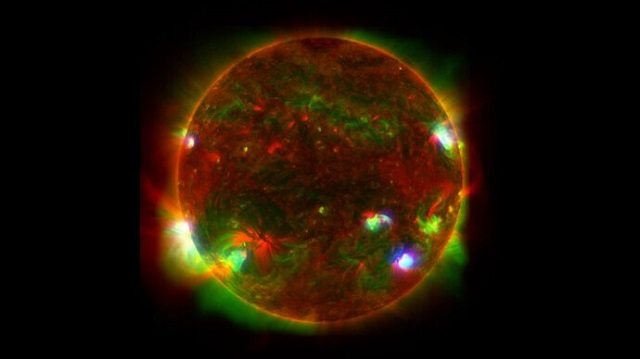NASA took an X-ray of the sun using its Nuclear Spectroscopic Telescope Array, or NuSTAR and released the images. No, NASA did not find any broken bones or evidence of a cancer tumor in the sun or anything like that. But it did find new evidence about the behemoth in the sky that keeps us all alive and warm.
Even on a sunny day, explains NASA, human eyes cannot see all the light our nearest star gives off. Think of ultraviolet and other colors that the human eye cannot see. The light spectrum is vast. And when we see a color, such as blue as in a blue shirt, it is because the dye used on the shirt absorbs all of the light around except for the blue light of a specific shade. That light is reflected and so it is what we see. Back is what we see when no light is reflected and white is what we see when all light is reflected at the same time. This is why the vastness of space is black; no light emanates from it.
A new image released by NASA displays some of the Sun’s hidden light, including the high-energy X-rays emitted by the hottest material in the Sun’s atmosphere, as observed by NuSTAR. While the observatory typically studies objects outside our solar system – like massive black holes and collapsed stars – it has also provided astronomers with insights about our Sun.
Will you offer us a hand? Every gift, regardless of size, fuels our future.
Your critical contribution enables us to maintain our independence from shareholders or wealthy owners, allowing us to keep up reporting without bias. It means we can continue to make Jewish Business News available to everyone.
You can support us for as little as $1 via PayPal at office@jewishbusinessnews.com.
Thank you.
In the composite image released, NuSTAR data are represented as blue and is overlaid with observations by the X-ray Telescope (XRT) on the Japanese Aerospace Exploration Agency’s Hinode mission, represented as green, and the Atmospheric Imaging Assembly (AIA) on NASA’s Solar Dynamics Observatory (SDO), represented as red. NuSTAR’s relatively small field of view means it can’t see the entire Sun from its position in Earth orbit, so the observatory’s view of the Sun is actually a mosaic of 25 images, taken in June 2022.
The high-energy X-rays observed by NuSTAR appear at only a few locations in the Sun’s atmosphere. By contrast, Hinode’s XRT detects low-energy X-rays, and SDO’s AIA detects ultraviolet light – wavelengths that are emitted across the entire face of the Sun.
The high-energy X-rays observed by NuSTAR appear at only a few locations in the Sun’s atmosphere. By contrast, Hinode’s XRT detects low-energy X-rays, and SDO’s AIA detects ultraviolet light – wavelengths that are emitted across the entire face of the Sun.
The Nuclear Spectroscopic Telescope Array, or NuSTAR, mission studies the universe in high energy X-rays to better understand the dynamics of black holes, exploding stars and the most extreme active galaxies.
In addition to complementing astrophysics missions studying the universe in various spectra, NASA says NuSTAR, the first hard-focusing X-ray telescope to orbit Earth, is expected to greatly improve on observations from ground-based observatories.




